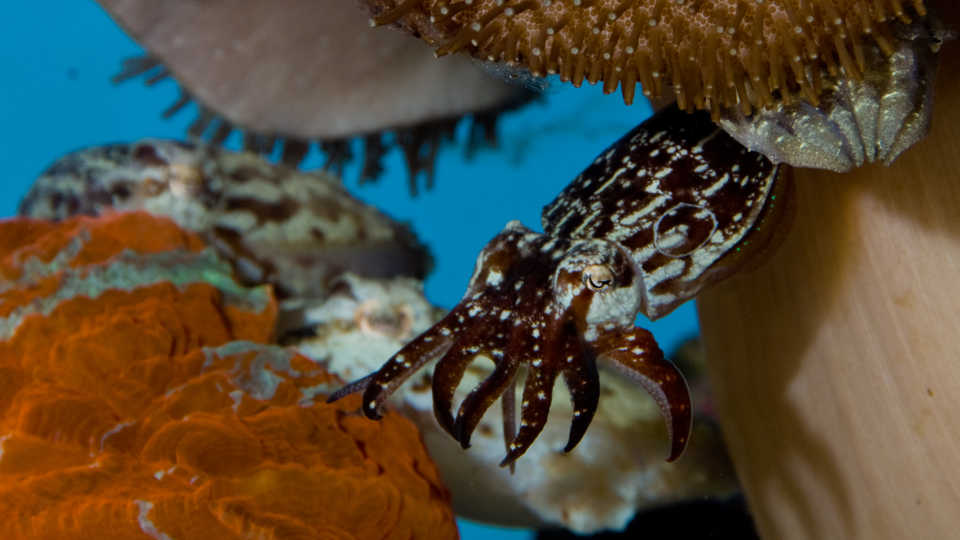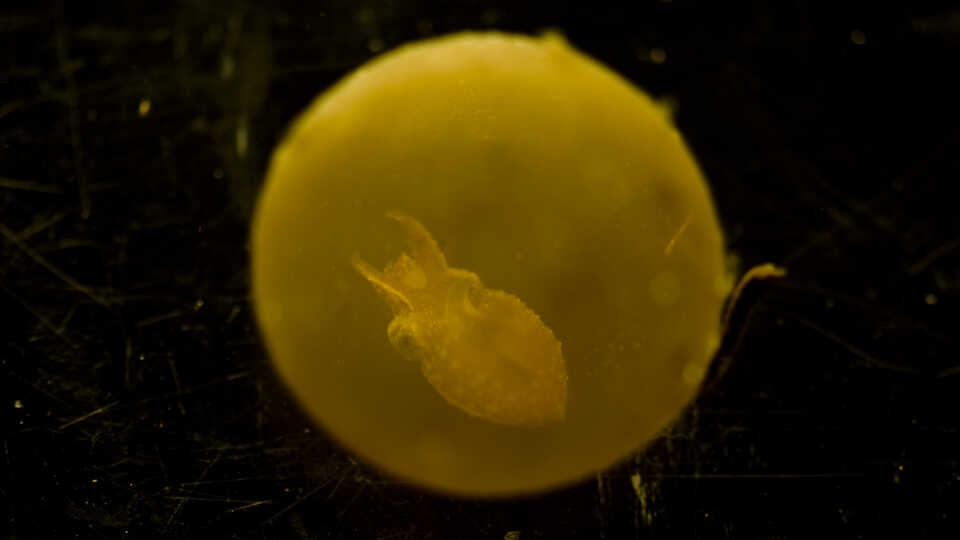The Academy's conservation breeding programs help contribute to Species Survival Plans and critical conservation efforts all over the world.
Breeding Programs
Dwarf Cuttlefish
Please note: This species is no longer part of the Academy's conservation breeding program.
Scientific name: Sepia bandensis
Range: Shallow coral reef habitat in the Indo-Pacific region, including the Philippines, Indonesia, and Papua New Guinea
Status: Not endangered
For scientists, cephalopods are an endlessly fascinating class of invertebrates to study. Known for their highly developed ring-shaped brains, color-changing abilities, tentacle-like limbs, and “extra” hearts (they’ve got three), this class counts squids, octopuses, cuttlefish, and nautiluses as its members. And if those extra tentacles, arms, and hearts weren’t enough to impress, cephalopods (save for the nautilus) also have specialized eyes—very similar to those of humans—that they rely on for hunting.
When they need to blend in, warn predators, or show off to potential mates, cephalopods can control thousands of tiny organs in their skin called chromatophores. These organs, which consist of a sac of pigments surrounded by muscles, can shrink or expand to form different patterns, colors, or shapes. Cuttlefish species, including the dwarf cuttlefish (Sepia bandensis), are less well-known and studied than octopuses and squids, but they can trump some of their relatives in chromatophore showmanship. Their most flamboyant act turns their skin into something akin to an LED screen, creating an impressive dance of changing colors and patterns across their bodies. This flashy behavior is thought to typically be used to mesmerize or distract prey prior to a fatal strike, but may also be used to enchant a potential mate.
But finding a suitable (and willing) female to mate with is only half the battle. Male and female dwarf cuttlefish vary in pattern and coloration; males tend to adopt a higher contrast black-and-white pattern when in the presence of other males, while females tend to stick with more mottled brown hues. To avoid unwanted attention from other aggressive males while attempting to find a mate, smaller male cuttlefish sometimes partake in a little strategic “cross-dressing.” They will alter their color and pattern to that of a female in order to sneak past their larger and more aggressive counterparts. It’s a bold move, and it works: On average, females reject 70% of all mating attempts, but they reject only 35% of attempts made by males who impress with cross-dressing.
Determining Breeding Methods
Dwarf cuttlefish may be good tricksters, but they’re not particularly good travelers. When Steinhart Aquarium biologist Richard Ross began looking for healthy cuttlefish in North America to raise in his home aquarium, he found that most of those being sold by aquarium suppliers were undernourished, stressed, or injured, likely resulting from their long journey from the Indo-Pacific. When he finally found a few healthy individuals, he began working on methods to breed them in captivity. Thanks to his efforts, the Academy became the first U.S. aquarium to develop a captive breeding program for dwarf cuttlefish.
There were plenty of problems to solve, however, before closing the species’ life cycle. Creating the right conditions for successful mating was one. S. bandensis is an aggressive species, and sometimes the sexually mature adults would injure themselves in fights or by trying to reach each other through dividers installed in the tanks. Once the cuttlefish mates and lays eggs—in clusters of anywhere from 8–40 sacs resembling small grapes—the hatchlings need a far different diet than their adult counterparts, who can devour prey the length of their own bodies. As a solution, the young cuttlefish at the Academy are fed at least twice a day on a diet of live Mysis shrimp, with food size increasing as they grow and learn to use their two feeding tentacles to snatch prey—typically small crabs.
Why Breed Cuttlefish?
Unlike other species for which the Academy has developed a breeding program, dwarf cuttlefish are not under any imminent threat of extinction. So why breed them? In Ross’s words, “Cuttlefish are like alien hummingbirds that hunt. They’re brutal predators. Their skin is amazing.” Due to their small size—around four inches long—dwarf cuttlefish are a prime candidate for showcasing in aquariums and most that have hatched at the Academy have been sent to other North American aquariums and research institutions. This small cuttlefish species uses fewer resources than its larger squid and octopus relatives, making it easier for aquariums of all sizes to showcase their captivating abilities and behavior.


